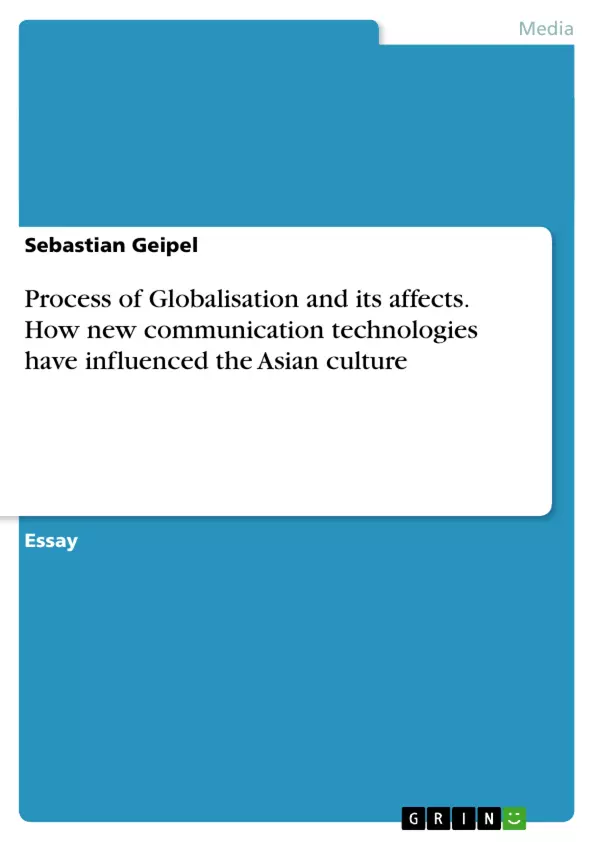Globalisation describes the major changes our society is going through, including the revolution in transport and new technology. All those points go along with each other, therefore a separation of economy and media is not advisable. These changes have contributed towards the expansion of the world economy, caused major changes in the composition and location of productio n and consumption activities, and reduced the ability of national and local governments to act independently and unobserved. As a result, globalisation has reshaped the way millions of people earn their living and the way societies are organised. This is not at last a result of the globalisation of the media. The media must be seen as an economical product. Globalisation is a multilateral process influencing everyone. The difference is just the way e.g. Asia deals with it. This paper will first describe the various meanings of globalisation and their indicators, followed by an analysis of the engines as well as dimensions of globalisation. Next, the effects of globalisation are highlighted. Finally, this paper ends with a conclusion.
Inhaltsverzeichnis (Table of Contents)
- Introduction.
- Globalisation..
- The Meanings of Globalisation
- The Engines of Globalisation.
- The Dimension of Globalisation..
- The Effects of Globalisation..
- Benefits.
- Drawbacks.
- Conclusion..
Zielsetzung und Themenschwerpunkte (Objectives and Key Themes)
This paper aims to analyze the process of globalization and its impact on Asian countries, with a particular focus on the role of new communication technologies. It explores the various definitions, drivers, and dimensions of globalization, examines its benefits and drawbacks, and highlights the role of the media in this evolving landscape.
- The multiple definitions and indicators of globalization.
- The key engines driving globalization, particularly in the context of communication and technology.
- The diverse effects of globalization on societies, economies, and individuals.
- The interplay between globalization and media, exploring its economic and social dimensions.
- The specific impact of globalization on Asian countries and their unique responses to this process.
Zusammenfassung der Kapitel (Chapter Summaries)
- Introduction: This chapter introduces the concept of globalization as a transformative force reshaping societies and economies, highlighting the interconnectedness of transport, technology, and media in this process. It emphasizes the global reach of globalization and its impact on individuals, businesses, and governments.
- Globalisation: This chapter delves deeper into the concept of globalization, exploring various definitions and indicators. It examines the contributions of the World Trade Organization (WTO) and other scholars in defining and understanding the dynamics of globalization. The chapter also explores the role of new technologies and information networks in driving globalization, particularly the impact of digitization.
- The Effects of Globalisation: This chapter examines the multifaceted effects of globalization, exploring its benefits and drawbacks. It explores the positive aspects of globalization, such as increased economic opportunities and technological advancement, as well as its negative implications, including social inequalities and cultural homogenization.
Schlüsselwörter (Keywords)
The key terms and concepts explored in this paper include globalization, communication technologies, media, Asian countries, economic integration, cultural exchange, information networks, digitization, benefits, drawbacks, and global governance.
- Arbeit zitieren
- Sebastian Geipel (Autor:in), 2003, Process of Globalisation and its affects. How new communication technologies have influenced the Asian culture, München, GRIN Verlag, https://www.grin.com/document/22224



